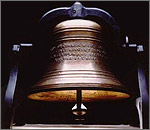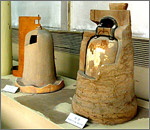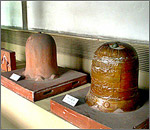
Bell casting is one of the metal casting process which is used to make bells(bell castings) of different sizes. For centuries, the basic process of making bells has not changed. Even today, when machines replace handwork, the process of bell casting still relies on skills handed down for generations.
To make a bell the bell founder first draws a design and builds a model of the bell in some suitable type of clay or brick. If the model is made of clay, it is allowed to harden. This is called the "core", and it has the shape and size of the inside of the bell which is to be cast.
In former times, this core was then coated thickly with wax, and another skin of clay, known as a "cope", was placed around it. Holes were drilled around the lower edge, heat was applied, and the wax melted and ran out through these holes. The space left between the core and the cope was then filled with molten metal. When molten metal sodifies it takes the shape of a bell which is broken out later. This process is called bell casting and the final product is bell or bell casting or bell castings.
Also in olden times, the loops on the crown of the bell, known as "canons" and from which the bells were suspended, were formed from straw coated with the same clay to the required shape. The straw was then set on fire and metal poured in to replace it.

Today, the core is covered with grease and a clay "false bell" is modeled over it. The false bell is greased, covered with more clay (the "cope"), and baked. When the false bell has cooled, the founders lift off the cope and remove the false bell. They then place the cope back over the core.
Into the space between the cope and the core, they pour the molten bronze. The metal used has changed very little throughout the ages. It is composed of pure copper and tin in the approximate proportions of 13 to 4 and is very durable subject only to an initial surface corrosion (or verdigris) which forms a protective coating against further oxidisation. It takes a week or more to cool and harden the finished bell.
Bell casting is known as founding. In earlier times, when a town made a bell it was a tremendous event in which the whole community would participate. Furnaces have been excavated from church courtyards, which tells us that bells were often cast on the spot. Bell-founders traveled from church to church. Later in the nineteenth century railroads made it possible to establish more centralized foundries.
Bell tuning can be the most crucial part of the process. Each bell has a different tone depending on its size. A big bell has a low tone and a small bell a high tone. For many centuries, to get the right tone, the founder would chisel the inside or outside of the bell. If the bell sounded too low, its tone could be raised by removing metal from the lower edge of the bell. If the tone was too high, it could be lowered by removing metal from the inside of the bell. European bells are now tuned by a lathe. An interesting feature of Russian bells, though, is that they are cast for a certain tone, and are finished when cast. That means they don't have a "pure" (abstract or machine-made) tone, but instead they have natural harmonics that give each bell a slightly distinctive voice. You can read more about the sound of a Russian bell

The clapper or tongue is attached to the inside of the bell either by a metal link or (in olden times) by a leather strap. Finally the bell is installed in the tower. Large bells were often cast in the ground where the tower was to be built; when the casting was complete, the tower was built over the casting pit, and the bell raised directly up into the tower.
After solidifying the bell castings or bells are often decorated with designs. Russian bells often feature icons, the name of the saint to whom the bell is dedicated, the year of casting, a prayer or some other commemorative inscription, and of course, usually the name of the founder or foundry.
Feel free to contact us to buy for for more information on bell casting, bell casting process, bell castings, machines and equipments used in bell casting.


